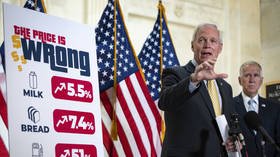Think rocketing inflation is bad now? We’re facing a catastrophe that will make the Great Depression look like a walk in the park

Western politicians and central bankers are quick to offer explanations for rapidly rising prices – from bottlenecks in supply chains to their favorite bogeyman, Vladimir Putin. They don't dare mention the real cause: themselves.
“Inflation is always and everywhere a purely monetary phenomenon” – Milton Friedman.
Prices in Western economies continue to skyrocket – whether in real estate, stock markets, cryptocurrencies, food, consumer goods, or energy. We are consistently seeing massive price increases that far outpace wage growth. In recent months, the situation has been getting increasingly worse, and we have heard nothing but excuses from the political establishment: from bottlenecks in supply chains to allegations that Russian President Vladimir Putin is personally manipulating the supply of natural gas. Of course, the Western establishment would never consider putting the blame where it belongs – on itself.
Although many in the financial industry and in business and politics try to disguise this fact, inflation is, at its core, an expansion of the money supply. Plain and simple. Price increases are merely a corresponding symptom of a growing money supply. The more money in circulation to chase goods, the more prices rise. Where price increases are most acute depends on how the newly created currency is distributed in society.
Also on rt.com High food prices are here to stay – Kraft HeinzAfter the United States failed to meet its obligation to redeem US dollars for gold in the early 1970s, it was able to drag the world onto the fiat currency system. This system uses paper currencies backed by nothing more than government decrees. The United States is at the heart of this system as the issuer of the world’s reserve currency – the US dollar. This special status allows the US to print the dollar to great excess because its status as a reserve currency creates foreign demand for it, which allows the US to export its inflation to the rest of the world. As a result, the US has the ability to create massive deficits. This mechanism also allows the European Central Bank (ECB) to create massive deficits as well, as long as it coordinates its monetary policy with the Federal Reserve. Of course, any country that rejects the US dollar usually ends up in the crosshairs of the US government.
Crisis, followed by crisis, followed by...
However, there is a catch. Every crisis is met with an expansion of the money supply and the manipulation of interest rates to stimulate artificial demand. This, in turn, lays the groundwork for the next, larger crisis by enabling ever greater mal-investment. In previous cycles, price increases resulting from a deliberate expansion of the money supply were largely confined to the stock markets and real estate, as much of the monetary expansion was concentrated in the financial sector, triggering a so-called wealth effect among holders of real estate mortgages and owners of stocks.
In the age of fiat money, central bankers and politicians would have us believe that inflation is a positive development. They set absurd “inflation targets” and insist that any inflation above their stated “target” of 2% per year is “transitory.” Federal Reserve Chairman Jerome Powell expresses this sentiment at almost every Federal Open Market Committee (FOMC) meeting, and ECB President Christine Lagarde has naturally echoed this belief.
Have you ever gone shopping and noticed that the price of your favorite product has doubled and jumped for joy because of the increase? No, of course you haven't. Inflation only benefits central banks and governments trying to pay off their massive debts. The only catch is that they have to destroy your purchasing power to do it – a fact they want to hide from you.
The monetary expansion that followed the Great Financial Crisis of 2008, that is, the printing of money, or quantitative easing (QE), to allow interest rates to fall to near zero, began to lose momentum in the fall of 2019 when serious problems developed in the overnight lending market in the United States – also known as the repurchase agreement (repo) market. Essentially, the Federal Reserve was trying to roll back the support it had provided in the wake of the 2008 crisis, which in turn led to the repo crisis. Of course, the 2008 crisis itself was triggered by the monetary policy response to the 2000 recession.
This monetary system is nearing its inevitable end
Central banks desperately needed an excuse to once again expand their balance sheets and cut interest rates. The repo crisis provided the Fed with the pretext to resume QE and pump tens of billions of dollars of liquidity into the market every month. It refused to call it QE at the time, but that's exactly what it was. Not long after that came the Covid-19 pandemic, which provided the perfect cover for Western governments, driven primarily by the structure of the current monetary paradigm with the world's reserve currency – the US dollar – and its issuer, the Federal Reserve, at its center, to once again conjure trillions of dollars and euros literally out of thin air and artificially manipulate interest rates to zero – even negative – in a desperate attempt to prop up the crumbling monetary system.
Also on rt.com Eurozone inflation at its highest since 2008 as energy prices continue to riseMuch of the current round of monetary expansion has been distributed to citizens in the form of helicopter money, or direct cash payments. This is a new development and a clear signal that this monetary system is nearing its inevitable end. Trillions in newly created currencies are now chasing the same supply of resources that existed before the pandemic. Basically, we live in a finite system with finite natural resources. Yet, at least for now, we still have the ability to infinitely expand the monetary supply with which to chase those finite resources, resulting in what amounts to endless artificial demand.
The spectre of hyperinflation
And now the catch. We are now at a point where Western central banks are, frankly, trapped. Interest rates have been artificially manipulated to zero. But neither the Fed nor the ECB has yet begun to reduce their balance sheets, although they keep saying they will eventually do so. Central banks now have no policy tools to respond to the next crisis. A crisis that will ironically and inevitably result from the misallocation they fueled by recklessly expanding their balance sheets and cutting interest rates to zero during the pandemic.
When the next crisis erupts, it will most likely come again from the repo market in the United States. Interest rates simply cannot be manipulated any lower as a countermeasure to the next crisis. If the central banks withdraw the current stimulus that our economies are currently hobbling along on, the whole system will collapse. That's why they only talk about reducing their balance sheets and allowing interest rates to rise instead of actually doing so. In the US alone, interest on the national debt is the fourth largest budget item – at interest rates of 0%! Imagine interest rates of 6%, 7% or 8% percent! The US would be bankrupt overnight. In response to the inevitable next crisis, they will have no choice but to flood the financial system with even more paper money, which sooner or later will lead to hyperinflation.
Western central bankers and politicians simply refuse to allow the necessary deflation that our system so desperately needs because over the last 50 years they have created a financial bubble so large that if left to burst unchecked it would plunge the world into a catastrophe that would make the Great Depression of the 1930s look like a Sunday walk in the park. However, their power rests entirely on this system, and they have no incentive to do the right thing.
What we need in the West is a strict, disciplined and controlled reduction in the money supply that would occur gradually over decades and a return to a sound monetary system. What we are currently experiencing and will continue to experience in the future is the exact opposite and will lead to the same catastrophic results that the uncontrolled bursting of the bubble would. As the unsustainability of the current paradigm becomes increasingly undeniable, the status quo will do everything in its power to maintain control of the collapsing system, including using climate change as an excuse to create trillions in new currencies out of thin air.
Our Western monetary system is like a brain-dead patient
Imagine an athlete on steroids. That athlete may seem unbeatable on steroids, but without those injections, we are left with something very unimpressive. An economy built on artificial 0% interest rates and constant injections of endless fiat money conjured out of thin air resembles that of an athlete on steroids, and we all know what long-term steroid abuse leads to. Unfortunately for us in the West, we have been abusing the proverbial steroids long past our physical expiration date. Right now, our Western monetary system is more like a brain-dead patient being propped up on life support.
Also on rt.com Rise in gasoline prices is another nail in the coffin of American workers’ budgets, but profits are put above people, as alwaysIn anything remotely resembling a free market, savings from productive undertakings are supposed to spur economic growth. Interest rates, which are simply the cost of borrowing money, are supposed to be determined by market forces, not a de facto politburo in the form of unelected central bankers. Businesses should grow because they remain competitive, not because they have access to cheap paper money conjured out of thin air by central banks. This is why Western mega-corporations never go away and just keep getting bigger. This happens at the expense of small businesses that don't have access to this cheap fiat.
The facade of democracy erected on the current monetary system will continue to collapse as this system is played out to its logical end – namely hyperinflation. And when the central bankers – and the politicians who enable them – finally bring the Western world to its knees, remember that they are the ones to blame – not the Russians, not the Chinese, no one else. Only them.
Like this story? Share it with a friend!
The statements, views and opinions expressed in this column are solely those of the author and do not necessarily represent those of RT.













